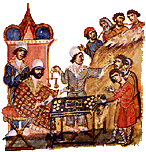 |
|
 |
The tax system
 he tax system of the late Byzantine period was the same as the
he tax system of the late Byzantine period was the same as the
 one in effect the middle Byzantine period. In determining the amount of tax to be paid, such factors as the size of the land owned and its nature (arable land, pastures, vineyards) were taken into account. Taxation was calculated by the modios, and was set at a percentage of the value of the modios. The modios was a unit of measurement of land, and varied according to the quality of the land measured. The taxation on livestock was calculated as a percentage, depending on the value of the animals. The farmers, who were taxed according to their category, were divided into zeugaratoi ("plough-owners"), voidatoi ("cattle-owners") and aktemones ("landless").
In the late Byzantine period, a form of cadaster was established, the so-called praktikon ("inventory"), which had made its appearance at the end of the middle Byzantine period. The registers recorded the limits, a description, and the extent of a large holding, and included also a list of the paroikoi, their families, their dwellings, their animals and lands and the tax that corresponded to each.
In the late Byzantine years, as well as in middle Byzantine times, the taxes were levied by the praktores, who bid at an auction for the right to farm the fiscal revenue of a province. one in effect the middle Byzantine period. In determining the amount of tax to be paid, such factors as the size of the land owned and its nature (arable land, pastures, vineyards) were taken into account. Taxation was calculated by the modios, and was set at a percentage of the value of the modios. The modios was a unit of measurement of land, and varied according to the quality of the land measured. The taxation on livestock was calculated as a percentage, depending on the value of the animals. The farmers, who were taxed according to their category, were divided into zeugaratoi ("plough-owners"), voidatoi ("cattle-owners") and aktemones ("landless").
In the late Byzantine period, a form of cadaster was established, the so-called praktikon ("inventory"), which had made its appearance at the end of the middle Byzantine period. The registers recorded the limits, a description, and the extent of a large holding, and included also a list of the paroikoi, their families, their dwellings, their animals and lands and the tax that corresponded to each.
In the late Byzantine years, as well as in middle Byzantine times, the taxes were levied by the praktores, who bid at an auction for the right to farm the fiscal revenue of a province.
See also: Paroikoi
|